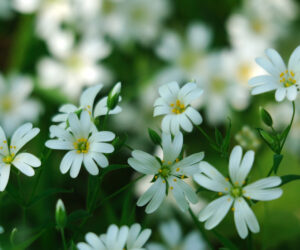Recognised by pretty star-shaped white flowers and grass-like leaves, greater stitchwort often forms impressive dense patches. It is commonly found on the edge of deciduous woodland, along roadside verges, hedgerows and grassy banks.
Behaviour
Greater stitchwort is a native perennial and has five white petals, each deeply notched and almost divided into two. Its stems are square and brittle, giving rise to one of its common names, ‘snapdragon’. It tolerates a wide range of soils, but does best on those that are moist, mildly acid and infertile.
These plants have an explosive seed-dispersal mechanism. When the seed capsules ripen, in late spring, they can be heard popping as seeds are released.
Greater stitchwort has larger flowers (2-3cm in diameter) than its relative, lesser stitchwort.
Size
- Height: up to 50cm
Status
Common
Distribution
Widespread native perennial that used to be ubiquitous throughout most of the UK, save for parts of Lincolnshire and Scotland where it has never been spotted. It is scarce in the far north west of Scotland and the west of Ireland and rarely found on the outer islands. It has disappeared in recent decades in parts of Scotland, along some coastal strips and much of Ireland. It avoids permanently wet conditions and the most freely-drained substrates.
When to see
April to June
Facts
- The more generally used common name greater stitchwort is reference to a herbal remedy in which the plant is allegedly used to cure that pain in the side, known as ‘stitch’, which can occur during exercise.
- It was once believed that picking these wildflowers would provoke thunder and lightning.
- Greater stitchwort has many common names including ‘Wedding Cakes’, ‘Daddy’s-Shirt-Buttons’, ‘Star-of-Bethlehem’, ‘Snapdragon’, ‘Milkmaids’ and ‘Brassy Buttons’.

